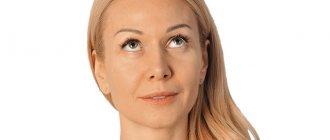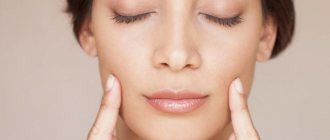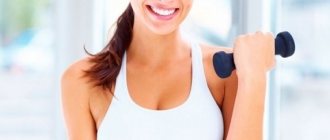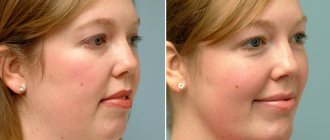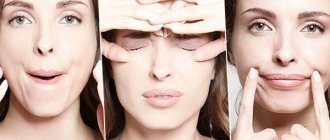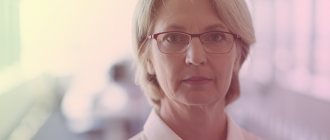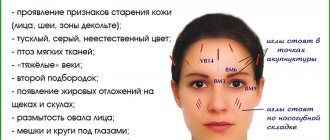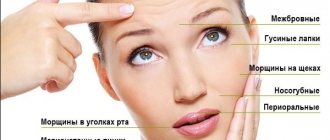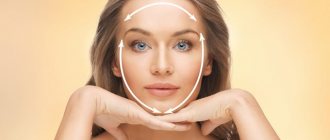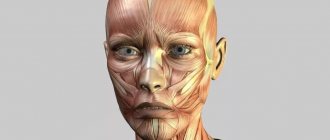Attention!
In each issue of our magazine, catch a new portion of exercises from Elena Karkukli. Collect a full range of exclusive exercises. The beginning is “PRO Health” No. 6.
Well-known internationally qualified face fitness coach Elena Karkukli says
- A person has a number of muscles that attach to the lower part of the face and pull the face down. These muscles pull our cheeks down, lower the lower lip and the corners of the lips. They become shortened by tension, facial habits, poor posture and incorrect head position. Therefore, in face fitness, we always not only train the muscles for a lifting effect, but also relax the depressor muscles so that the face does not fall down.
Article on the topic
A look into the future.
How will you look in old age Olga Shablinskaya, PRO Health: What exactly should you do?
— For a beautiful oval face, relaxation and stretching of the masticatory muscles is very important. The muscles of mastication support the frame and the entire middle part of the face. Relaxation, stretching, and massage of the strained muscle are important.
— It turns out that in face fitness the same laws apply as in regular fitness: first you need to work on the muscle, then stretch it.
— Absolutely right, after training the muscles need to be gently stretched and relaxed, that is, restore the balance between the elevator muscles, which raise the face, and the depressor muscles, which lower the face. We need to not only raise our cheeks, but also maintain a soft and pleasant facial expression, which is difficult to achieve if the muscles are tense.
— There is a saying: a woman’s age is revealed by her hands and neck. Why is the neck so prone to wrinkles?
— Our habits are of great importance. The entire front surface of the neck is covered by muscles, and when we lower our chin down, these muscles contract. Spending a lot of time on phones, gadgets or in front of the computer at work, constantly lowering our head down and pressing our chin to our neck, we cause these muscles to shorten more and more and thin skin gathers into folds faster. Therefore, in order to achieve a guaranteed result, it is very important to control the position of your head throughout the day and perform exercises for posture and neck (see PRO Health No. 6).
For a perfect oval face and smooth neck skin
"Swing"
Photo: AiF/Eduard Kudryavitsky
Starting position: sit up straight, back straight, pull your head by the crown. Place one palm on your neck as shown in the photo. Don't push! Pull the skin down slightly for light resistance, literally 3mm.
Smile. Stick out your tongue and stretch it upward, as if trying to reach the tip of your nose. Use your other hand to secure the folds around your lips. To perform the exercise, sit on the edge of a chair. Lean back a little and rock back and forth (like on a rocking chair) - the movement is from the pelvis. Repeat 20 times. Watch your posture, keep your back straight! Don't throw your head back.
Result: the corners of the lips are raised, jowls and double chin are reduced, and the oval of the face is improved.
Review of post-gymnastics care products
After exercise, the skin needs to be nourished as much as possible. Pay attention to products with natural ingredients.
- Vegetable squalane serum - light sugar cane oil will quickly saturate your skin without chemicals.
- Coconut oil is a unique product that is ideal for caring for the entire body and even hair. But people with oily skin types should use it with caution.
- Camellia sasanqua oil contains vitamins and acids that will nourish not only your skin, but also your hair and nails.
- Eye pads with a relaxing effect - after eye exercises, they will help you achieve an additional effect, and then fall asleep.
To strengthen the front of the neck
Photo: AiF/Eduard Kudryavitsky
Starting position: back straight. Join your wrists. Place your hands on your neck. Tighten your neck muscles, slightly moving your neck forward, while keeping your head in place. Provide light resistance with your hands. Do it dynamically 20 times. The exercise is performed very delicately. Do not press your head on your hands. To properly activate the muscles during the exercise, you can press your tongue into the upper palate.
Result: tightened, smooth neck skin.
To relax the masticatory muscle
Photo: AiF/Eduard Kudryavitsky
Starting position: place your fingers on the masticatory muscles at the level of the earlobes (as in the picture). Make clockwise gentle circular movements in place, relaxing the area. Repeat the movements counterclockwise. 30 times in each direction.
Result: recession of the cheeks and loss of their volume are reduced, facial proportions are restored.
Why do you need face fitness?
Face fitness is a set of exercises for the face that helps to relax hypertonic muscles and tone other relaxed ones, thereby normalizing balance.
The effectiveness of face fitness has been confirmed by American scientists. As part of a study at Northwestern University in the United States, women 40–65 years old performed face and neck exercises for 30 minutes a day for 20 weeks.
Scientists noted that as a result, the subjects’ skin tightened in 18 out of 20 study areas, and the women themselves looked an average of three years younger. Exercises in the cheeks and chin area were especially effective.
"Cat"
Photo: AiF/Eduard Kudryavitsky
Starting position: lips are relaxed, tongue is stuck out as far as possible. Twist your tongue upward as if you were lapping up water, like a cat. It is very important to feel tension while performing the exercise. Repeat 25 times. Do not purse your lips, make sure there are no creases on your face.
Result: a clear oval face without a double chin.
How everything works
The facial anatomy of each person is complex, individual and unique, like the skin pattern on the fingers. There are mimically gifted people who innately have additional facial muscle fibers, and they know how to control them. If such physical talent coincides with artistic talent, they become brilliant actors.
There are more than 100 muscles in the head and neck. Conventionally, they can be divided into:
- muscles of the neck and surrounding areas;
- chewing muscles;
- muscles of the mouth and tongue;
- oculomotor muscles.
Muscles are also divided into skeletal and facial muscles. What is the difference? The former, as a rule, have strong ligaments, are covered with dense fascia and are attached to the bones, causing them to move. An example of skeletal muscles on the face is the masseter, pterygoid, and temporalis.
The facial muscles are special: they have no ligaments, no dense fascia, and they are attached at one end to the bones of the skull, and at the other they are woven into the skin or intertwined with neighboring muscles. Some of the facial muscles have no attachment to the bones at all, only to soft tissues. The movements of the facial muscles are controlled by the facial nerve.
If skeletal muscles are divided into flexors and extensors, then some of the facial muscles are divided into levators, which lift the skin upward, and depressors, which pull it down. There are also circular muscles - sphincters, which narrow the natural openings (eyes and mouth).
Dynamic stretching of the masseter muscle
Photo: AiF/Eduard Kudryavitsky
Warm-up: carefully open and close your mouth 5 times. Make sure you don't have any clicking joints.
Starting position: place your fingers on the chewing muscles and three fingers on your earlobes. Slowly lower your lower jaw, while firmly (without fanaticism) press your fingers against the muscle and press on it, pushing it up, thus providing resistance and stretching the muscle. Hold for 5 counts and return to the starting position. Repeat 5 times.
Result: restoration of the oval of the face, the angle of the lower jaw, reduction of recession and loss of volume of the cheeks, reduction of the habit of clenching teeth, restoration of facial proportions.
To relax and stretch the masticatory muscles
Photo: AiF/Eduard Kudryavitsky
Starting position: open your mouth. Gently massage the chewing muscles from top to bottom with the pads of your fingers or bent knuckles. Perform this massage for 30 seconds.
Result: restoration of the oval face, beautiful lines.
Exercise with fists
Photo: AiF/Eduard Kudryavitsky
Starting position: fold your hands under your lower jaw, press your elbows to your chest. If you can't keep your back straight, lean against the back of a chair. Do not push your head forward, otherwise the exercise will be ineffective and there will be a risk of damaging the back of your neck. Press your tongue onto the upper palate, resisting with your hands, and hold for 1-2 seconds. Perform 25 times at a slow pace. Relieve tension with light pats under the chin.
Result: reduction of the double chin, tightened skin of the neck and lower face.
FACE FITNESS. STAGE 1: PREPARATION
The first secret that will help increase the effectiveness of face fitness is proper skin preparation. Don't skip this step. You will pre-warm up your muscles, just like before a workout, and make them more receptive to subsequent exercises.
- Tie your hair up or tuck it behind your ears to give you a clear view of your face and neck.
- Sit in front of the mirror without tilting or throwing your head back. Straighten your back. Place your feet so that both feet are flat on the floor, parallel to each other. This will relieve tension from your back and neck.
- Using gentle movements, following the massage lines, apply a light moisturizer to your face and neck.
- Massage your neck with light circular movements. Pay special attention to the back surface, where clips are most likely to form.
, the OK Beauty Hydrating & Balancing moisturizing facial cream is perfect . It contains amino acids, peptides and hyaluronic acid, which will make the skin softer, therefore more receptive to further manipulation. Peptides help fight wrinkles, so the cream will enhance the effect of facial exercises.
To relax the chin muscles
Photo: AiF/Eduard Kudryavitsky
Starting position: grab your chin with your fingers, stroke it down. Make sure your lips are relaxed. Repeat 3-5 times. Don't pull the corners of your lips down. Don't overdo it: you can easily get bruises on your chin.
Result: relaxation of the mental muscles, softening of the jawline.
Article on the topic
What will erase years from your face? Timeline of the appearance of wrinkles
What is face fitness
Many women, when they first heard about facial fitness, do not fully understand what it is and how to use this technique correctly. As the name implies, face fitness is a complex of massage and exercises for the face, a kind of gymnastics designed to keep the skin more elastic and youthful and prevent the formation of wrinkles. These exercises have many other names, such as face lifting, face shaping, face yoga, and so on. For the first time, massage to preserve youthful facial skin was mentioned back in 1710 in France: Jeanne Sauval, who worked as a housekeeper in a rich house, wrote down the secrets of the mistress of the house, who took care of herself and performed these exercises almost daily.
In our time, the popularity of this method was brought by the American cosmetologist Carol Maggio, who published her book “Aerobics for the skin and muscles of the face” in 1995. At the age of 36, she herself was the victim of a botched rhinoplasty that gave her nose an unnatural appearance, which is why she began to look for alternative ways to combat the aging process without the use of plastic surgery.
The method has become popular due to the fact that it does not require special tools or a lot of time. A standard set of face fitness exercises takes 10-15 minutes and is performed without the use of additional equipment or tools. Facial gymnastics is recommended for everyone after 25 years of age, and the frequency of exercises depends on the initial result of the face: to maintain skin tone and preserve youth, it is recommended to perform exercises 2-3 times a week, to work with the first wrinkles - 3-5 times, and for people over 50 years, 5-7 approaches every week are recommended.
Our tissues need water
There are many factors that influence muscle loss and reduction. It is important for each of us to consume enough clean water. Average calculation: 30 ml per kilogram of weight. At a young age, we are 70-80% water, and the older we get, the smaller this percentage is. And even if you drink the amount of water your body needs every day, but at the same time drink 5 more cups of coffee a day, you safely “neutralize” this water and remove it, so dehydration continues. Accordingly, our bones, our muscles, and ligaments lose water, but our tissues need it constantly. Therefore, for the beauty of your face, it is important to follow a drinking regime.
❌ Face fitness: contraindications
• Cosmetologists do not recommend doing gymnastics when there are abrasions, burns, cuts, acne or other damage on the face. Wait for complete healing.
• Do not do facial exercises if you are prone to nervous tics, pinched facial nerves, etc.
• Postpone face fitness if you are sick with a viral or infectious disease.
• Face fitness is not recommended for people with diseases of the lymphatic system.
Ready?
Below you will find 5 simple facial exercises. Do them every evening for 20–30 minutes, and within two to three weeks you will notice the first results.
Tip: Take several “Before” selfies from different angles on the first day. Every week on the same day, take new selfies from the same angles and record the date. Noticeable progress will help you not stop halfway towards your goal.
